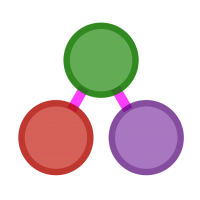Graph interfaces, bespoke graphs for every occasion¶
Mathieu Besançon, James Fairbanks
Outline¶
- Why LightGraphs?
- LightGraphs scope
- Live code!
- Conclusion
Why LightGraphs?¶

Graphs are fun... and useful.
Need for a simple, extensible graph library in Julia.
Watch Seth and James JuliaCon17 talk for motivation
Graph applications¶
 Social interactions
Social interactions
 Logistics
Logistics
LightGraphs scope¶
LightGraphs' job is to...
- Define the core interface: what does a type need to be a graph?
- Implement essential algorithms on types implementing the interface
Core interface¶
Abstract graph type AbstractGraph
Some methods required on graphs f(graph):
- LightGraphs.edges
- LightGraphs.edgetype
- LightGraphs.is_directed
- LightGraphs.ne
- LightGraphs.nv
- LightGraphs.vertices
Methods required on nodes f(graph,node):
- LightGraphs.outneighbors
- LightGraphs.inneighbors
- LightGraphs.has_vertex
Methods required for edges f(graph, edge):
- LightGraphs.has_edge
Defining one own edge type:
- Base.reverse
- LightGraphs.dst
- LightGraphs.src
Essential algorithms¶
using LightGraphs
g = CompleteBipartiteGraph(5,6)
{11, 30} undirected simple Int64 graph
# neighbors of the 3rd vertex
neighbors(g, 3)
6-element Array{Int64,1}:
6
7
8
9
10
11
# Dijkstra's shortest path from vertex 3 to any other
dijkstra_shortest_paths(g,3)
LightGraphs.DijkstraState{Int64,Int64}([6, 6, 0, 6, 6, 3, 3, 3, 3, 3, 3], [2, 2, 0, 2, 2, 1, 1, 1, 1, 1, 1], Array{Int64,1}[Int64[], Int64[], Int64[], Int64[], Int64[], Int64[], Int64[], Int64[], Int64[], Int64[], Int64[]], [6, 6, 1, 6, 6, 1, 1, 1, 1, 1, 1], Int64[])
# Kruskal min-cost spanning tree
kruskal_mst(g)
10-element Array{LightGraphs.SimpleGraphs.SimpleEdge,1}:
Edge 1 => 6
Edge 5 => 11
Edge 5 => 10
Edge 5 => 9
Edge 5 => 8
Edge 5 => 7
Edge 5 => 6
Edge 4 => 11
Edge 3 => 11
Edge 2 => 11
pagerank(g)
11-element Array{Float64,1}:
0.0992624
0.0992624
0.0992624
0.0992624
0.0992624
0.083948
0.083948
0.083948
0.083948
0.083948
0.083948
Standing on other packages' shoulders¶
using GraphPlot
gplot(g, layout=GraphPlot.circular_layout , nodelabel=1:11)
Flow algorithms like a charm¶
import LightGraphsFlows
const LGF = LightGraphsFlows;
flow_graph = DiGraph(4)
capacities = zeros(4,4)
add_edge!(flow_graph, 1, 2)
capacities[1,2] = 5.
add_edge!(flow_graph, 2, 4)
capacities[2,4] = 3.
add_edge!(flow_graph, 1, 3)
capacities[1,3] = 2.
add_edge!(flow_graph, 3, 4)
capacities[3,4] = 3.;
gplot(flow_graph, nodelabel = 1:4)
flow_value, flow_mat = LGF.maximum_flow(flow_graph, 1, 4, capacities)
flow_mat
4×4 Array{Float64,2}:
0.0 3.0 2.0 0.0
-3.0 0.0 0.0 3.0
-2.0 0.0 0.0 2.0
0.0 -3.0 -2.0 0.0
# flow in lexicographic order
flow_list = [flow_mat[1,2],flow_mat[1,3],flow_mat[2,4],flow_mat[3,4]]
gplot(flow_graph, nodelabel = 1:4,edgelabel = flow_list)
A graph type for every occasion¶

What's the simplest way to build a graph?¶
- Adjacency matrix $M_{ij}$ $$M_{ij} = \begin{cases} 1, & \mbox{if edge (i $\rightarrow$ j) exists} \\ 0 & \mbox{otherwise}\end{cases}$$
- One matrix contains all the information
- Undirected graph == symmetric matrix
- Accessing, modifying edges is quick
To follow along $\rightarrow$ http://bit.do/graphdocs
Wrap-up¶
- Design specialized graph types for your needs, you know best!
- Define a couple functions describing behavior
- Use the JuliaGraphs ecosystem for free, build on top
React, complain, contribute:
- github.com/JuliaGraphs
- Discourse
- Slack
#graphschannel
Bonus¶
One graph type to rule them all
struct GraphMatrix{MT<:AbstractMatrix{Bool}} <: LightGraphs.AbstractGraph{Int64}
m::MT
is_directed::Bool
end
# methods on the graph
is_directed(g::GraphMatrix) = g.is_directed
reverse(g::GraphMatrix) = is_directed(g) ? GraphMatrix(m',true) : g
edgetype(::GraphMatrix) = LightGraphs.SimpleGraphs.SimpleEdge{Int64}
ne(g::GraphMatrix) = is_directed(g) ? sum(g.m) : div(sum(g.m),2)
nv(g::GraphMatrix) = size(g.m)[1]
vertices(g::GraphMatrix) = 1:nv(g)
function edges(g::GraphMatrix)
n = nv(g)
if g.is_directed
return (LightGraphs.SimpleGraphs.SimpleEdge(i,j) for i in 1:n for j in 1:n if g.m[i,j])
else
return (LightGraphs.SimpleGraphs.SimpleEdge(i,j) for i in 1:n for j in i+1:n if g.m[i,j])
end
end
edges (generic function with 4 methods)
13.047 ns (0 allocations: 0 bytes) that's better.
Links & sources¶
Photo by Fancycrave on Unsplash
https://www.pexels.com/photo/close-up-photography-of-yellow-green-red-and-brown-plastic-cones-on-white-lined-surface-163064/
https://www.pexels.com/photo/firework-new-year-s-eve-rocket-3893/
https://www.pexels.com/photo/blue-white-orange-and-brown-container-van-163726/

